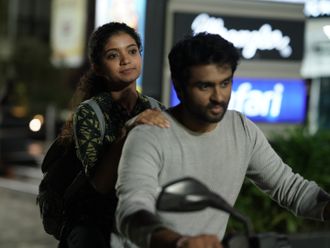
Madafati is the Arabic word for a place that is a home away from home. Loreta Bilinskaite-Monie has chosen this as the title of her first exhibition in Dubai because it perfectly describes how she feels about the city and the UAE.
Seven years ago, the artist and interior designer from Lithuania came to Dubai on vacation and liked the city so much that she decided to stay on. Her artworks, depicting icons and symbols of the UAE intricately detailed with beads, sequins and thread on fabric, are her tribute to a place where she feels completely at home. The artist has combined pop art with traditional craftsmanship to present her contemporary interpretation of the UAE's history and culture.
"Dubai is a great city for artists and has given me many interesting creative opportunities. As an interior designer, I have been fortunate to work closely with many Emirati families while decorating their homes and majlises. ... They have always made me feel like I have a big family here despite being so far from home. This exhibition expresses my feeling of being accepted and welcomed here and celebrates the UAE's heritage, its multicultural community and its dynamism," Bilinskaite-Monie says.
The artist chose to use embroidery in her work because her own country has a strong tradition of embroidery. "As a child, I always saw the women in my family embroidering dresses and decorative items for the home. During my fine arts course at St Martin's School of Art in London, I was fascinated to learn about the Bayeux tapestry, which was embroidered in the 11th century by monks. It tells the story of the Norman conquest of England in 1066 and besides being a work of art, it is also an invaluable representation of life in France more than 1,000 years ago.
"Traditional Emirati garments are also beautifully embroidered and there are so many skilled embroiderers from various countries working here. Hence I thought the best way for me to chronicle life in Dubai was to create my own version of the Bayeux tapestry," she says.
Her ideas are simple but to execute them, Bilinskaite-Monie spent months working closely with Pakistani embroiderers in a tiny tailoring shop in Satwa. Their first creation was a set of four portraits of Shaikh Zayed. "He was a legend and people speak about him with so much love and respect. I wanted to pay tribute to him by depicting him as a larger-than-life icon," she says. She has also included traditional elements of Emirati culture such as the burqa, created from golden sequins on black abaya fabric, and henna patterns, created from beads. "Only women from the older generation wear these burqas now. So I wanted to celebrate and preserve this tradition through my work," she says.
The artist has an interesting take on traditional henna patterns. "I have studied old henna books and found that there are specific patterns for various special occasions. So in a sense, these designs are logos from ancient times," she says.
In a lighter vein, she has transformed imagery from daily life in Dubai into pieces of art. The Dh1 coins she needs every day for parking, the popular Nissan Patrol vehicles she sees on the roads and in the desert and the packets of Marlboro cigarettes her Emirati friends like to smoke, have all been lovingly recreated on her canvases.
The most colourful pieces are a set of jellabiya fabrics embellished with the names of the seven emirates of the UAE. "I love the vibrant prints of the jellabiyas worn by Emirati women and have carefully selected every print to reflect the ethos of each emirate. I deliberately embroidered the names in Arabic to convey the message that not knowing the local language does not prevent us from appreciating the local culture," she says.
Along with the artworks, the artist is also showing a video about a day in her life during the making of these pieces. The video reveals the unique connection formed between people of different countries and cultures in Dubai.
"A lot of hard work and collaborative effort has gone into the making of these artworks. I have tried to document everything from the tiny Afghan bakery where I started my day with freshly baked bread and tea to the cramped, noisy workshop where my Pakistani craftsmen and I worked for more than eight hours a day. My day was quite different from that of most Dubai residents but I loved every minute of it," Bilinskaite-Monie says.
Jyoti Kalsi is a UAE-based arts enthusiast.
Madafati will run at The Third Line gallery's Projects space until October 21.








